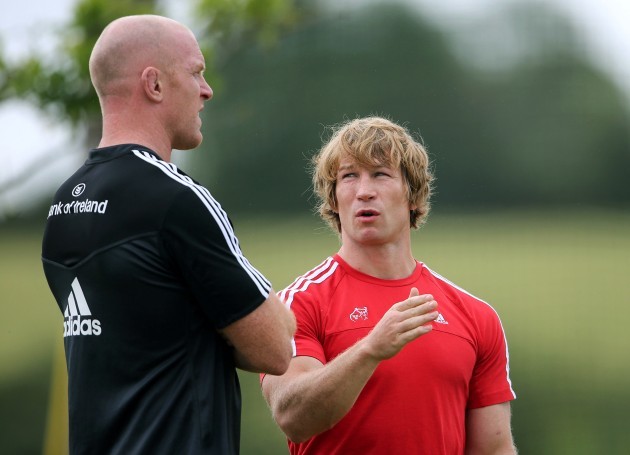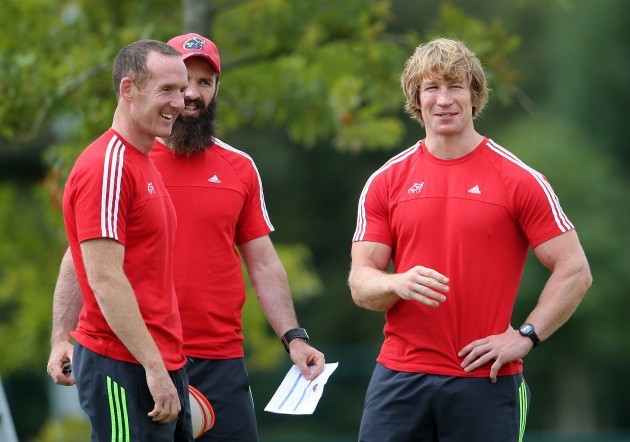TWO SHORT YEARS after retiring as a Munster player, Jerry Flannery is back with the province and hoping to inspire more trophy success.
Still just 35, the former hooker is now installed as scrum coach under Anthony Foley, working with the forwards to improve a set-piece that remains crucial to the game despite the law alterations of recent times.
The same process-focused mindset that drove Flannery to honours as a player is likely to be a crucial factor as his first season in the world of professional coaching gets underway. ‘Fla’ has returned to where he feels he belongs.
When I retired, I had always wanted to go back to Munster,” Flannery told TheScore.ie. “I had seen it as a goal of mine, a dream of mine, that I would end up back here. Now, I had no idea that it would be so short a time between retiring and coming back.”
After Heineken Cup wins with Munster in 2006 and 2008, as well as a Grand Slam with Ireland in 2009, Flannery was forced to hang up his boots in 2012 as more than two years of consistent injury problems finally forced him out of the game.
Never one to stand still, the 41-times capped front row immediately jumped into a Master’s degree in Sports Performance at the University of Limerick, dealing head-on with “that weird floaty year when you retire.”
Having secured that qualification, Flannery briefly spent time with Rugby Canada, before accepting a year-long position in Premier League club Arsenal’s strength and conditioning department, primarily working with academy players.
“I can take a certain amount of that back,” says Flannery. “You’re working in an elite sporting professional set-up. For me the main thing was the actual coaching, the nature of coaching, the style of coaching, development, how I was going to be around the players.”
That last point is one of particular intrigue with Flannery now part of Munster’s backroom staff. Second row Paul O’Connell has mentioned that he finds himself “trying to keep a straight face at times” as his ex-teammate delivers instructions and prompts.
Given his sharp wit and reputation as a stand-out character in Irish rugby, Flannery admits to being in a somewhat unique position, but one that he is managing maturely.
I’ve got to go in and do all my preparation, have as much knowledge on these areas as I can. With regards to dealing with the players, you’ve got to be very measured in what you say. I would have always been pretty chatty and had a laugh with the lads as a player.
“As a coach, you’ve got to draw a boundary. It’s sometimes about saying less rather than more; it’s got to be measured,” continues Flannery. “But you’ve got to be pretty real in that you can’t pretend you’re somebody else now.
“I’ve got to manage my energy a little bit differently in a training scenario, but then I can relax and be myself a little bit more off the pitch, while still keeping a level between coach and player. I don’t think the players would respond well to you pretending you’re somebody new.”
Flannery underlines that he is fortunate to be coaching players that are “intrinsically very, very motivated,” and points to the influence of BJ Botha and his “bank of knowledge” as an aid in his role as scrum coach.
While Flannery is also working with Munster’s hookers on their throwing, helping Ian Costello with defence and dealing with other aspects of “tight five work,” it is the scrum upon which his work will be judged.
Ideally you want to use the scrum to disrupt the opposition ball and to give a platform for your own team to launch attacks,” outlines Flannery. “It’s rare that you’re going to have 16 players tied into such a small area on the field.
“One of the biggest things is trying to coordinate the eight forwards. Philosophy-wise, it feeds into what is best for the team at all times. The clearer you can make each player’s role and what’s required of them in each area, the easier it is for them on the field. Shit happens when you’re playing, so the more prepared they are, the better.”
“When a prop is highly fatigued, he needs to come to the scrum and have a process to focus his mind. It’s about putting all those processes and pieces together.”



